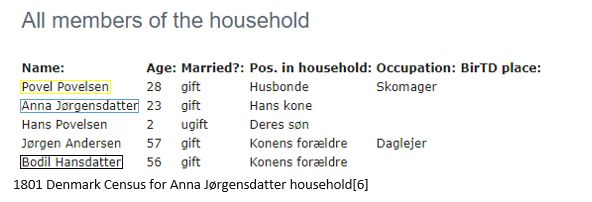Danish Research Part 1 : The Census
 16
16Oct

Denmark is a small country with a big history. Its historical boundaries included at various times, most of Norway, part of Sweden, part of Germany, Iceland, Greenland, and the Faroe Islands. Like the other Scandinavian countries, Denmark adopted the Lutheran religion and made it the state church in the 1500s. Along with the rest of Scandinavia, Denmark also experienced a great upheaval in the 19th and early 20th centuries due to emigration. As a result of its far-reaching historical boundaries and the great number of emigrants, many people can find their ancestors in Danish research records.
Danish Research
Basic Danish Records
There are two foundational record types everyone should know about before searching for their Danish ancestors.
Church Parish Records
The Lutheran priests kept track of christenings, marriages, and burials from the 1600s forward for every person in the country. Additionally, the priest kept track of people moving in and out of the parish from about 1814 to 1875.[2] The country was divided by the church into diocese, clerical districts, and then parishes. There was a priest assigned to each parish and that priest kept the records. Church records are considered foundational to any Danish genealogy research
Have you found your Danish ancestor in all their church records?
Danish Censuses
The Danish government has regularly taken censuses of the population since 1769. While some of the censuses are not complete for the entire country, they are valuable tools for building a family. They always record the name and age of a person. They also often include relationship to others in the household and the later censuses include a birthplace. The censuses were taken in the years listed below(the 1769 census was not preserved):
The 1700s
1787
The 1800s
1801/1803, 1834/1835, 1840, 1845, 1850, 1855, 1860, 1870, 1880, 1890
The 1900s
1901, 1906, 1911, 1916, 1921, 1925, 1930, 1940
Because censuses were taken so regularly, following a family through the generations can be very straightforward. See the example below.
Using the Danish Censuses
Take a look at this family in the 1930 Denmark census. The parents and children are listed. This census gives an exact birthdate and a birthplace.

We will look at Amalie’s maternal line. Maternal lines are often considered the most difficult to trace. We will see how far back we can go using the censuses. In order to find Amalie’s parents, we should look at the 1880 census when she would have been 7 years old.

Here are Amalie’s parents. You might wonder how to be sure that this is the correct family. In this case, there was only one Amalie born in Rø sogn who was the right age. Now let’s look at her mother, Ane Bohn. In the 1834 census she would be 6 or 7 years old depending on when her birthday occurred. See below:

Another great find! She was the only Anne Marie in a family with the surname Bohn(e). We found her parents, Mons and Kirstine. The bonus in this census is the man listed at the bottom. Since Kirstine, the mother, is a Poulsdatter[daughter of Poul], it is likely that Poul Poulsen is her father. If we check for a Poul Poulsen in the next census, 1801, we find:

Initially, this may not seem like a match, because Poul’s name is different, the age is slightly off, and Kirstine is not there. However, the name Poul is interchangeable with Povel. While the age is a little off (the 1834 census would suggest Poul/Povel should be 31/32), it was the only possible match and Kirstine was not born until 1806. Nevertheless, this is the only Povel/Poul out there who could be a match for Kirstine’s father.
Once again, the wife’s parents are living with the family. Jørgen and Bodil are referred to as Konens forældre (wife’s parents). To see if there is anything else to find, we will go to the earliest available country-wide census, 1787.

The ages are off again, but this is the only family that fits. We are to the end of the censuses, but in total we found six generations of women on Amalie’s maternal line, not to mention the fathers and the siblings. We spanned a time period of 143 years in one family and all we had to look at were the censuses.
Have you found all the censuses for your family?
Where to Search the Danish Censuses
There are three main websites used for searching the Danish censuses.
FamilySearch has made all the censuses between 1834 and 1930 searchable on their free website. The downside is that the censuses can be difficult to search. Only a small portion of the information on the record was indexed.
MyHeritage is not free, but it has put all available censuses on their website and is easier to search than FamilySearch. Using this link, the list of Denmark censuses is on the sidebar.
- Dansk Demografisk Database - https://ddd.dda.dk/soeg_person_enkel_uk.asp.
DDD is free, but because it is powered purely by volunteers, some areas in the various censuses have not been indexed. You might find that only half of a particular county has been indexed. However, when it is indexed, it is completely indexed, meaning that it is easy to search. This is the website that was used in the presentation above. This website is particularly good for searching the censuses by location. The one drawback is that this website uses an exact search, so when spelling varies it can be tricky.
Conclusion
Censuses are extremely helpful in Danish genealogy research. Combined with the other foundational record, the parish records, genealogy lines can be extended or built down easily. While the example presented above was simplistic and without any obstacles, other situations might be trickier. This could be due to the search area being more heavily populated or a family moving around frequently. Fortunately, there are plenty of records to overcome these obstacles. If you have not found all the censuses for your Danish family, then get started today! If you run into problems, Price’s expert Danish researchers can help.
This blog is part 1 in a 2-part series. Look for the next blog on the biggest problem in Danish family trees and how to get past it.
-Forrest
[1] “Boat going up the river in Copenhagen,” accessed 15 October 2020, https://www.goodfreephotos.com/denmark/copenhagen/boat-going-up-the-river-in-copenhagen.jpg.php.
[2] “Denmark Church Records,” FamilySearch, last updated 2 September 2020, accessed 15 October 2020, https://www.familysearch.org/wiki/en/Denmark_Church_Records.
[3-7] Dansk Demografisk Database, https://ddd.dda.dk.
Do you have any questions about Danish research? Let me know in a comment below!
